





























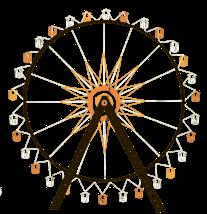





















MUNICH IN A STATE OF UNRESTRAINED MERRIMENT 10 THE CELEBRATION OF BEER 12
98
RIDES AND SHOWMEN
YVONNE HECKL 100
172 LITTLE BAVARIAN ABC

SITE PLAN 16
18
AUGUSTINER FESTZELT 22 FISCHER VRONI 26 AMMER HÜHNER- UND ENTENBRATEREI 30 ZUR BRATWURST 34
38 MUSIC
JOSEF MENZL 40
44
LÖWENBRÄU-FESTZELT 48
SCHÜTZENFESTZELT 52
HOCHREITERS HAXNBRATEREI 56 KALBSBRATEREI 60
64
TRADITIONAL OUTFITS
66 SPATEN
SCHOTTENHAMEL FESTHALLE 70
OCHSENBRATEREI 74
MARSTALL FESTZELT 78
GLÖCKLE WIRT 82
WIRTSHAUS IM SCHICHTL 86
GOLDENER HAHN 90 WILDSTUBEN 94
HACKER-FESTZELT 106 PSCHORR-BRÄUROSL 110
ENTEN- UND HÜHNERBRATEREI HEIMER 114 ENTEN- UND HÜHNERBRATEREI POSCHNER 118
122 BOOTHS AND STALLS
HOFBRÄU FESTZELT 130
134
AFTER-WIESN
136
PAULANER
PAULANER FESTZELT 14O ARMBRUSTSCHÜTZENZELT 144 KUFFLERS WEINZELT 148
KÄFER WIESN-SCHÄNKE 152
MÜNCHNER KNÖDELEI 156
MÜNCHNER STUBN FESTZELT 160 HEINZ WURST-UND HÜHNERBRATEREI 164 METZGERSTUBN 168

174 COFFEE TENTS
CAFÉ KASIERSCHMARRN 178
BODO'S CAFÉZELT & COCKTAILBAR 182 CAFÉ THERES 186
SCHIEBL'S KAFFEEHAFERL 190 WIESN-GUGLHUPF 194
198 ALTERNATIVES TO THE OKTOBERFEST

200
OIDE WIESN
FESTZELT TRADITION 204
HERZKASPERL-FESTZELT 208 SCHÜTZENLISL 212
216
WHICH TENT FOR WHICH TYPE?
220 RECIPE INDEX
224 IMPRINT
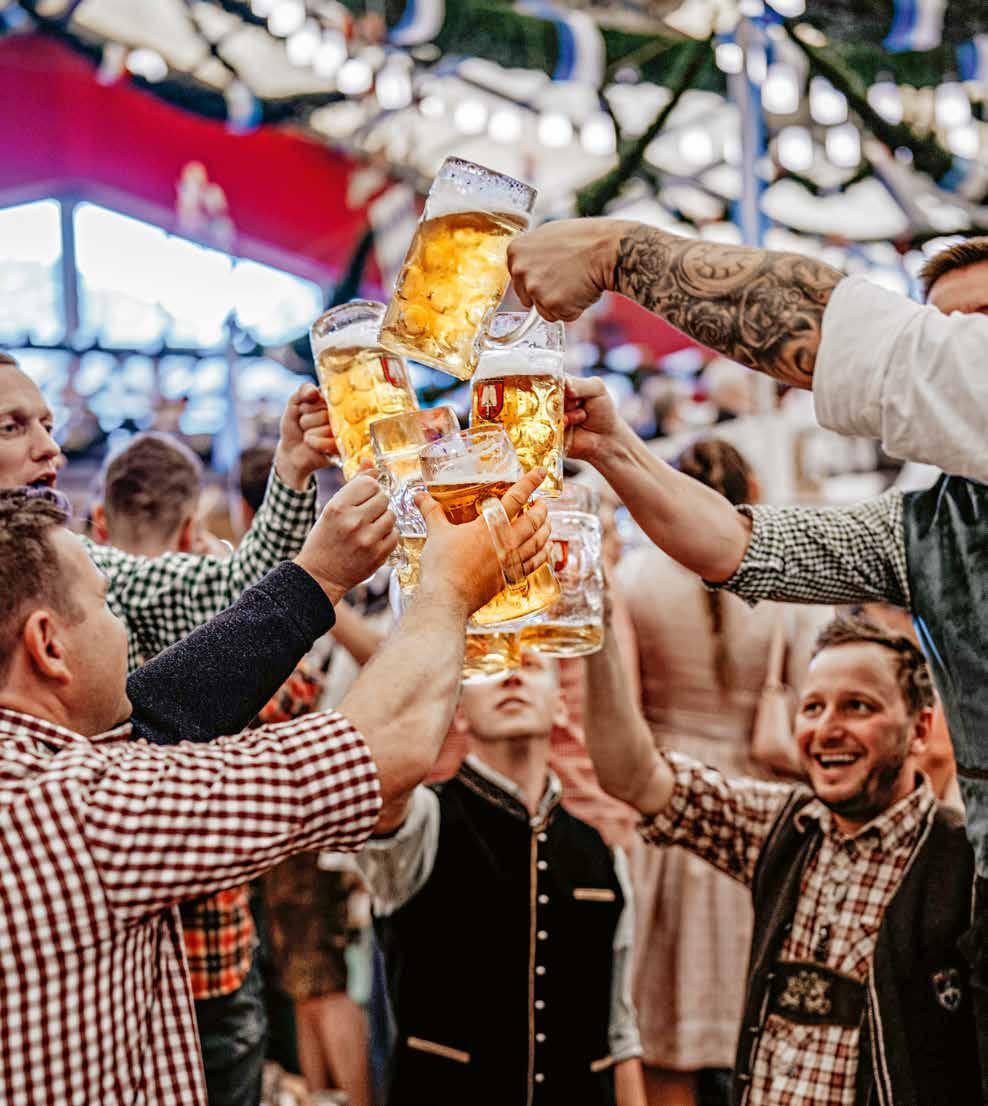


When Oktoberfest was first created in 1810 at the wedding of Crown Prince Ludwig, later King Ludwig I, to Therese von Sachsen-Hildburghausen, Munich was not really a beer city. Wine was served in the royal tent, and after the horse races, the commoners usually relocated to the inns in the city center. Not that beer wasn’t important back then–it was indeed important very early on, because the fermentation process meant that beer was always a better and safer drink than regular water, which was often contaminated. This was one of the reasons why Munich had its first purity law for beer as early as 1487, a precursor to Bavaria’s purity law of 1516.
Beer has always been important in the city; it is not a coincidence that the oldest existing businesses are breweries, and most of them can be traced back to the early days of Munich. These are often monastery breweries, as the monks not only brewed for themselves, but also for the people, which helped finance their monasteries. But there was also a brewing industry with breweries run by private citizens in the city starting around 1250, as they had been granted brewing rights by the respective lords. Following secularization, a large number of brewing rights were transferred to people in the city, who were soon called “beer barons.”
the 19th century, the brewing industry made enormous progress and the craft was now backed by scientific methods. This technological upgrade also led to numerous acquisitions and mergers. Out of 74 smaller breweries in 1630, just six remained at the end of the 20th century, two of which belonged to the international group AB-InBev–Spaten/Franziskaner and Löwenbräu–and two others to the Schörghuber Group, which Heineken
also has a stake in, Paulaner and Hacker-Pschorr. The other two major players are Hofbräu and Augustiner. Together, these six are allowed to supply the beer for Oktoberfest, because they obtain their water from Munich’s deep wells, they are based in Munich, and they are able to supply a sufficiently large quantity of beer. A new start-up from the large group of Munich’s up-and-coming brewers, Giesinger Bräu, is about to fulfill the last condition. The head of the brewery, Steffen Marx, is not yet ready to take the final step, but it probably won’t be long now.
The people of Munich, however, have long since accepted their global reputation as residents of the city of beer. Most of them are even proud of it, and they embrace their personal brand of beer as if it were a religious belief. When they go to Oktoberfest, they have short nicknames for their favorite tent and go to “den Ochsen” or “zum Löwen.” When taking their first sip of the new one, many of them also claim they can remember exactly what the Wiesnmass tasted like the previous year, and then use their expertise to make a comparison. But one thing is certain, it was always cheaper last year. This is another of the rituals surrounding the Wiesn: People wait with bated breath for the announcement of the beer price, which takes place sometime in early summer. Then at least half of the people in Munich shake their heads in disapproval at the increase in the price of beer in just one year, finding this quite outrageous in general. Prices are, of course, also rising in beer gardens and in normal life, but it is the Wiesn and not normal life. Among the six to seven million visitors to the Wiesn every year, it is claimed that nobody has ever gone without another beer just because it was less expensive the year before.




VOLKSSÄNGERZELT ZUR SCHÜTZENLISL

MUSEUMSZELT
U3/U6 POCCISTRASSE






HERZKASPERLZELT

FESTZELT TRADITION




KÄFER WIESN SCHÄNKE


SCHÜTZEN FESTZELT







OIDE WIESN STRASSE 4

PAULANER FESTZELT
EIN-/AUSGANG

EIN-/AUSGANG STRASSE 5



KUFFLERS WEINZELT



LÖWENBRÄU FESTZELT


U3/U6 GOETHEPLATZ

SCHOTTEN HAMEL FESTHALLE

PSCHORR FESTZELT BRÄUROSL




U4/U5 SCHWANTHALERHÖHE






SCHOTTENHAMEL FESTHALLE




HOFBRÄU FESTZELT HACKER FESTZELT
WIRTSBUDENSTRASSE

PSCHORR FESTZELT BRÄUROSL
STRASSE 3



AUGUSTINER FESTHALLE
SCHAUSTELLERSTRASSE

FAMILIENPLATZL


ARMBRUST SCHÜTZEN FESTZELT

MARSTALL FESTZELT
HAUPTEINGANG

1 STRASSE 2
OCHSENBRATEREI

FISCHER VRONI









U4/U5 THERESIENWIESE


SERVES 4
FOR THE STUFFING
250 g bread cubes
150 ml/⅔ cup milk
5 pinches nutmeg
6 pinches salt
5 pinches of ground pepper
4 eggs, beaten Parsley, finely chopped
FOR THE VEAL BREAST AND SAUCE
1 kg veal breast
(with a pocket cut for stuffing)
Salt
Ground pepper
Paprika powder
Caraway seeds
1 bunch soup vegetables, f inely chopped (mirepoix)
10 small shallots, sliced in rings
3 cloves garlic, sliced
100 ml white wine
500 ml/2 cups vegetable stock
500 ml/2 cups veal stock
1 bay leaf
1 potato, finely grated
Cold butter cubes for finishing the sauce
1 Have your trusted butcher prepare the veal breast and cut a pocket for stuffing. Keep the breast in the refrigerator until ready to use.
2 To make the stuffing, put the bread cubes in a bowl and pour the boiling milk over them. Season with nutmeg, salt, and pepper. Add the eggs and the parsley to the lukewarm mixture and combine. Cover and let stand for approximately 30 minutes.
3 Preheat the oven to 220 ºC.
4 Check the stuffing mixture for firmness; it should feel firm.
TIP: If it is too soft, add some breadcrumbs and let it thicken a little.
5 Now stuff the veal breast with the bread mixture and close with toothpicks, shashlik skewers, or heat-resistant roasting twine. Place the meat in a large roasting pan and season with salt, pepper, paprika, and caraway seeds. Reduce the temperature to 170 ºC.
6 After 45 minutes, add the soup vegetables, shallots, and garlic. Brown for an additional 35 minutes, then add the white wine, vegetable stock, and veal stock. Add the bay leaf. After 15 minutes in the oven, baste the roast with sauce (glaze). Repeat several times until the end of the cooking time of approx. 2 to 2½ hours. You can add more stock if you desire.
7 To make the gravy, remove the meat and leave to rest in the oven. Strain the juices into a pan, bring to a boil, and thicken with the finely grated potato. Season to taste with salt and pepper and stir in the cold butter. Bring to a boil again to finish the sauce.

TIP ON COOKING TIME:
This varies depending on the oven. Pierce the center of the veal breast with a metal skewer and test the temperature by holding it against your lip. When the center of the needle feels hot to the touch, your roast is ready to serve.
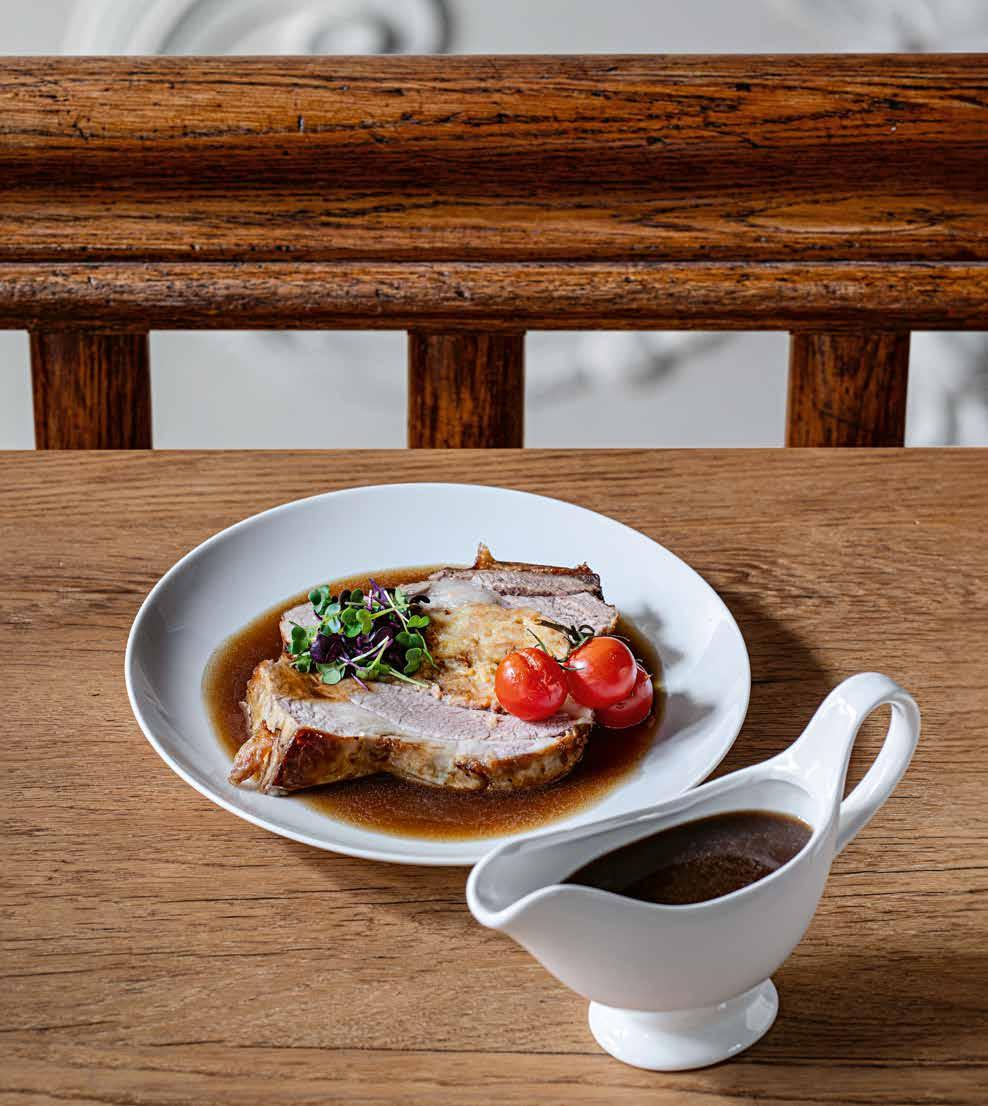



Every year, someone pops up and claims to have just written the new Wiesn hit. Strangely enough, however, this has never worked out; apparently you don’t write a Wiesn hit to become a Wiesn hit. Instead, a Wiesn hit is created during the course of the Oktoberfest and then suddenly appears. Prerequisites: You have to be able to clap and sing loudly along to it, it can’t be too vulgar (like at the infamous Ballermann party beach of Majorca), it can’t be too intellectually demanding, but it can have an element of humor about it. And sometimes, like in 2023, it might just be a pop song that has been around for 40 years.

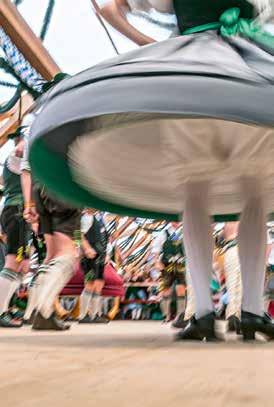
Georg Lang (1866-1904), landlord of the Krokodil restaurant in Nuremberg, changed Oktoberfest fundamentally in every respect. In 1898, he built the first large tent for 6,000 guests on the Theresienwiese. To get the space for it, five straw men applied to the city council on his behalf. A 30-piece band played in his new “I. Bayerische Riesenhalle.” Lang had 50,000 song booklets printed to enable the beer tent guests to sing along, and it is said that he personally added the toast “Oans, zwoa, drei – gsuffa!”(one, two, three, drink!) to the “Prosit der Gemütlichkeit.” The “Prosit,” written by the Bremen journalist and composer Georg Kunoth (1863–1927), is still the most popular song at Oktoberfest today.


The Krinoline merry-go-round is not only a unique historical ride, a waltzing carousel for mature children and adults, it is also one of the few places at Oktoberfest where classic Bavarian folk music is still played. The Krinolinen band, however, has vigorously protested this claim: “We don’t play folk music, we play beer music!” This “beer music” is also captured on a wonderful CD published by the Austrian label of the “Attwenger” musician HP Falkner in 2000 in collaboration with the postcard publisher, badge maker, DJ, graphic artist, Munich original and native Austrian Hias Schaschko (Krinoline Blaskapelle: Biermusik! Fischrecords, distributed by Indigo/Hoanzl, live daily at the Wiesn, 3:00 pm-11:00 pm).
If you wanted to hear all the bands from every tent live, you would be busy for a whole Oktoberfest. Fortunately, however, there is a convenient opportunity to hear them all at once on the middle Sunday of Oktoberfest at the Bavaria. At 11:00 am, all the bands gather for a standing concert on the steps leading up to the monumental statue and play a program of marches and dances. It is regularly broadcast live on Bavarian television and achieves astonishingly high viewing figures. The concert is of course even more entertaining in person. One attraction includes various dignitaries and Wiesn celebrities being allowed to conduct individual pieces. This often not only looks funny but would also lead to serious musical accidents if the musicians actually followed the rules.

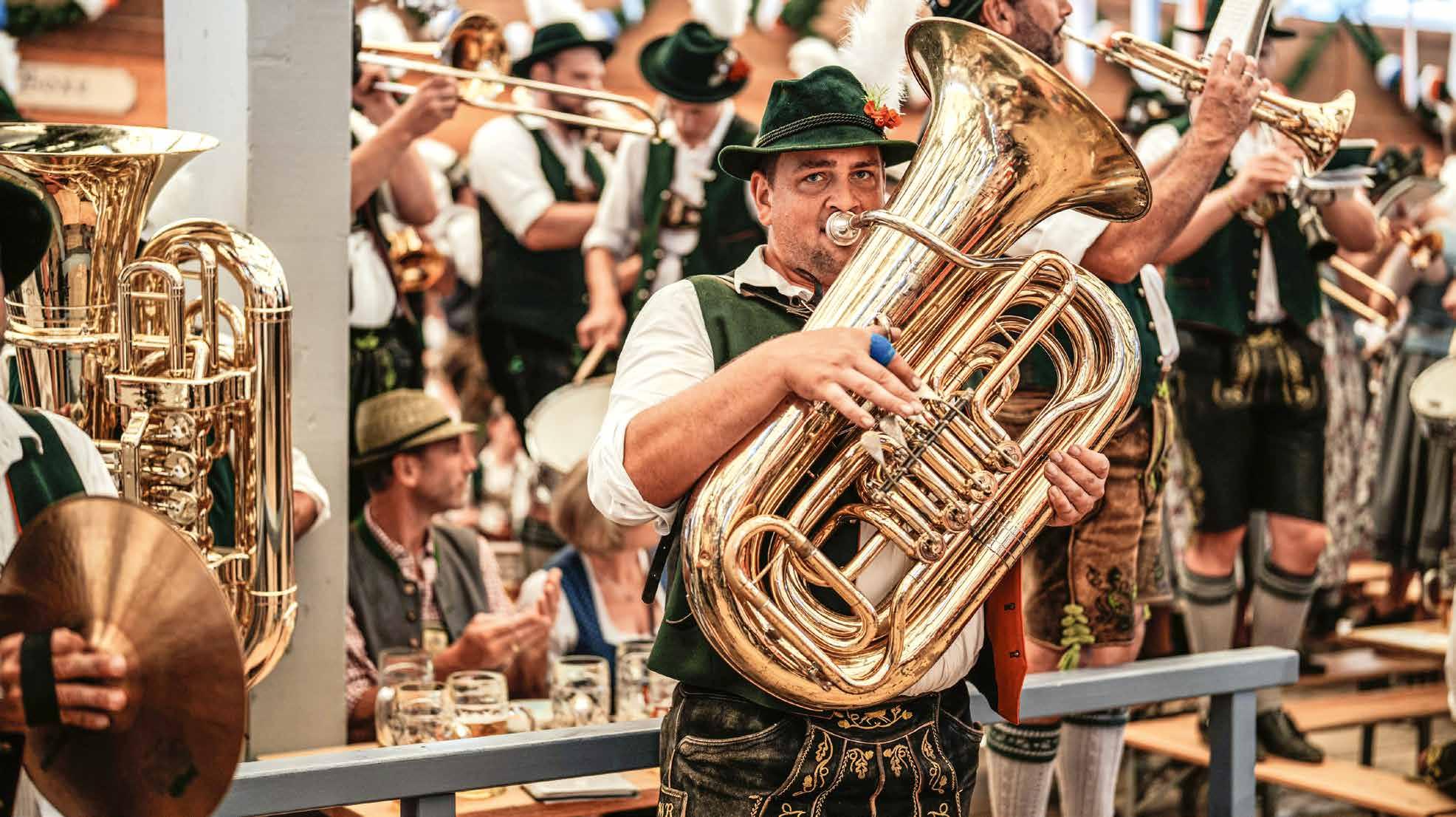

FOR THE POTATOES AU GRATIN
1.5 kg waxy potatoes
2 onions
2 cloves of garlic
4 tsp butter
400 g cream/ 1½ cups (at least 15% fat)
400 ml milk/1½ cups (at least 3.5% fat)
2½ tsp salt
Pepper to taste
1¼ tsp nutmeg
5 tbsp Parmesan cheese
200 g/2 cups cheese, grated
FOR THE CAFÉ DE PARIS SAUCE
2 small shallots
2 garlic cloves
7 anchovy fillets
300 g/1½ cups Kerrygold butter
1 tsp Port of Hamburg Curry
1 tsp hot paprika
250 g/1 cup cream
Several stalks of tarragon, flat-leaf parsley, thyme
2 tbsp small capers
Juice from 1 lemon
2 pinches sea salt
2 pinches pepper symphony
2 tsp Dijon mustard
FOR THE VEAL
4 veal tomahawk steaks, approximately 300 g each
Sea salt
Ground pepper
Herb mix of your choosing
(such as steak spice mix, BBQ spice, smoked paprika powder, smoked salt)
Butter
Herb oil
1 Preheat the oven to 180 °C using the top and bottom heat setting. Peel the potatoes and cut into very thin slices. Finely chop the onions and garlic. Grease a casserole dish with butter. Pour the cream and milk into the dish and mix with salt, pepper, nutmeg, and Parmesan. Then add the potato slices, onions, and garlic, mix well. Bake in the preheated oven for 30 minutes, then sprinkle with the grated cheese and dot with flakes of butter. Bake for another 30 minutes until the potatoes au gratin are golden brown.
2 Our interpretation of the legendary Café de Paris steak sauce: Finely dice the shallots and finely chop the garlic and anchovy fillets. Melt the butter in a pan and sauté the shallots, garlic, and anchovy fillets in it. Add the curry powder and paprika powder and stir everything together. Let the sauce simmer over low heat. Finely chop the parsley, tarragon, and thyme. Add the cream to the butter mixture in the pan, bring to a boil, and add the chopped herbs and the capers. Add the lemon juice, salt, pepper, and mustard.
3 Season the tomahawk steaks generously with sea salt and let stand for 30 to 40 minutes. Preheat the grill. Grill the steaks for 1½ to 2 minutes on each side. Then season with black pepper and sprinkle with the desired spices. Place a few pieces of butter on the steaks and continue to cook on indirect heat at approx. 150 °C to the desired doneness (approx. 50-55 °C core temperature).
4 Drizzle the sliced steaks with herb oil or melted butter, add the potatoes au gratin, and pour the Café de Paris sauce over it.


SERVES 4
FOR THE VEGAN SAUSAGE
2 to 4 tbsp Paulaner beer
3 tsp carrots, finely chopped
2 tsp corn
1 tsp leek, finely chopped
4 tbsp pea protein
4 tbsp fava bean protein
1 tbsp vinegar
1 tbsp apple cider vinegar
1 tbsp onion, finely chopped
1 tsp garlic, finely chopped
2 tsp jalapeño pepper, finely chopped
1 tsp salt
1 tsp pepper
1 tsp chili
1 tsp paprika powder
1 to4 tsp locust bean gum
3 tbsp canola oil for frying
FOR THE RISSOLE POTATOES
20 rissole potatoes
20 ml olive oil
1 tsp fresh parsley, chopped
1 tsp fresh chives, chopped
FOR THE HOT SAUCE
120 g bell peppers, finely chopped
Canola oil for frying
1 tsp curry powder
250 ml vegetable stock
500 ml organic ketchup
100 g organic applesauce
1 tsp ground white pepper
1 tsp chopped garlic
2 tsp dark balsamic vinegar
1 tsp salt
1 tbsp sambal oelek
FOR THE FRIED ONIONS
Oil for frying
2 to 3 onions
150 g flour
60 g paprika powder
2 tsp salt
FOR THE SPICE MIX
2 tbsp curry powder
2 tbsp paprika powder
2 tbsp ginger powder
2 tbsp cayenne pepper
1 Place all the ingredients for the vegan sausage in a blender or food processor and process into a smooth mixture. Add locust bean gum as needed until the mixture has reached the desired consistency. Season to taste.
2 Form 4 sausages from the mixture. Heat the canola oil in a frying pan and fry the sausages in it until crispy.
3 Peel the potatoes, cook until slightly al dente, then drain. Season with salt and set aside. Before serving, fry in olive oil on all sides and sprinkle with parsley and chives.
4 To make the hot sauce, heat the canola oil in a frying pan and sauté the bell pepper pieces in it. Dust with curry powder and deglaze with vegetable stock. Add the ketchup, applesauce, pepper, garlic, balsamic vinegar, salt, and sambal oelek, and simmer, stirring constantly, until the peppers are soft. Season to taste and reduce the temperature.
5 To make the fried onions, preheat oil in a pan or deep fryer to 160 °C. Cut the onions into thin slices, dust with flour and paprika powder, and fry until golden brown. Drain on paper towels, then lightly salt.
6 Combine the curry, paprika, ginger powder, and cayenne pepper to make the spice mix. Arrange the sausage and potatoes on plates as desired, drizzle with the sauce, and sprinkle the spice mix over the vegan sausage and sauce.
An Guadn!


SERVES 4
FOR THE SPINACH DUMPLINGS
250 g toast
75 g/⅓ cup butter (room temperature)
250 g baby spinach
1 onion
1 clove of garlic
60 ml/¼ cup milk
Freshly grated salt and pepper
Freshly grated nutmeg
3 eggs
50 g breadcrumbs
125 g/½ cup quark (40% fat)
60 g/½ cup flour
FOR THE CHERRY TOMATO SAUCE
1 onion
1 clove of garlic
3 to 4 tbsp olive oil
1 tbsp tomato paste
150 ml/2/3 cup white wine
600 g cherry tomatoes
1 to 2 stalks basil
1 to 2 sprigs oregano and rosemary
Salt
Ground pepper
Sugar
PREPARATION OF THE SPINACH DUMPLINGS
1 Preheat the oven to 180 °C. Cut the toast into small cubes. Place half of it on a baking tray and spread 40 g of butter on top. Toast the bread cubes in the oven on the middle rack for about 12 minutes until golden brown.
2 Sort the spinach, rinse off, blanch, and immerse it in an ice water bath. Then squeeze out all the excess liquid and finely chop.
3 Peel and finely dice the onion and garlic. Heat the remaining butter in a frying pan and sauté the onion and garlic. Pour in the milk and season with salt, pepper, and nutmeg. Briefly bring to a boil.
4 Combine the toasted and untoasted bread cubes, spinach, eggs, breadcrumbs, quark, flour, and the milk and onion mix in a bowl, mix thoroughly. Wet your hands and shape it into dumplings. Cook in boiling salted water. Remove the spinach dumplings, drain, arrange on top of the cherry tomato sugo and garnish with basil pesto and basil as desired. Serve and enjoy!
Serve and enjoy!
PREPARATION OF THE CHERRY TOMATO SAUCE
1 Peel and finely dice the onion and garlic. In a frying pan, heat the olive oil and sauté the onion and garlic. Add the tomato paste and briefly sauté. Deglaze with wine.
2 Rinse the cherry tomatoes, cut in half, and add to the pan. Let everything reduce over low heat.
3 Rinse the herbs, pat dry, remove the leaves or needles, and finely chop. Add the herbs to the sauce and season with salt, pepper, and sugar to taste.
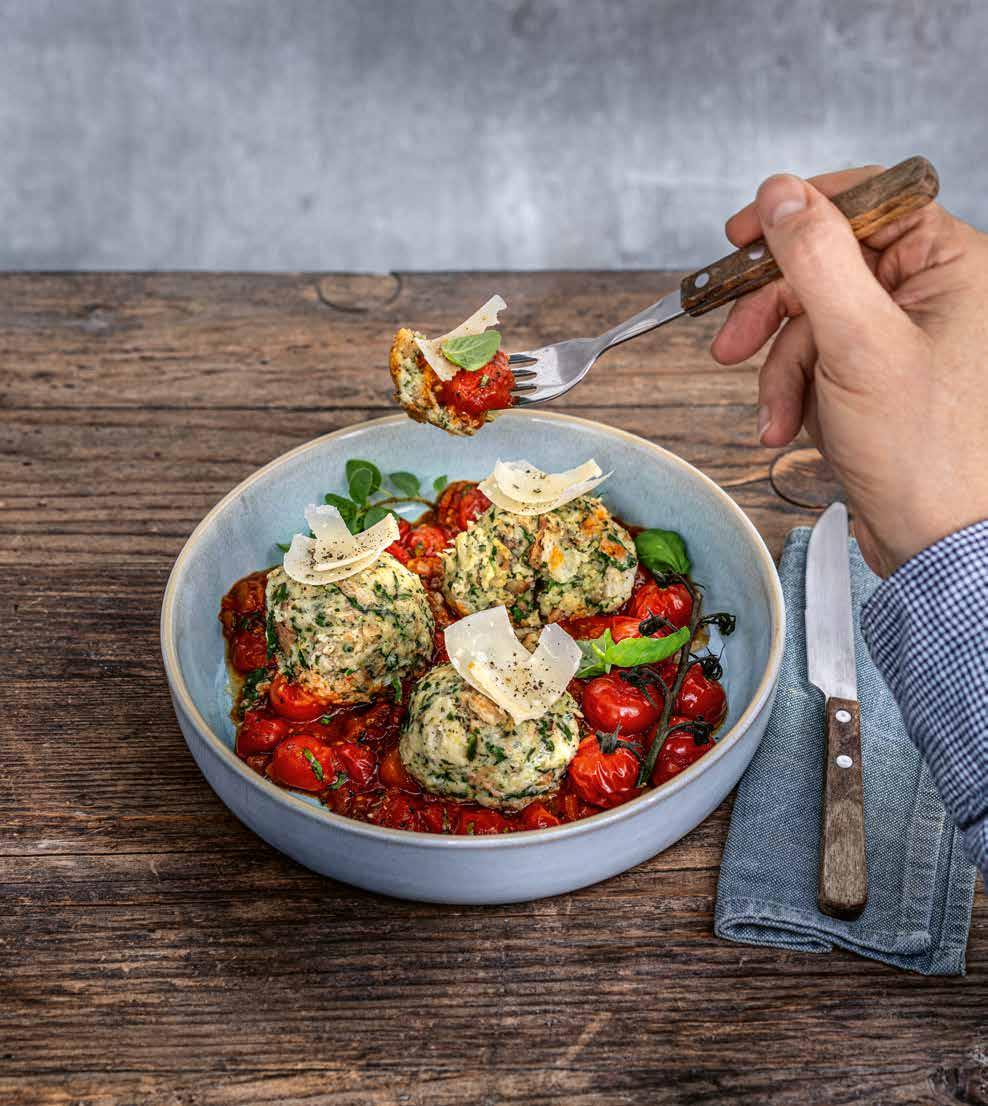

SERVES 5 FOR THE PASTRY
5 eggs
20 g sugar
100 g /¾ cup flour
200 g /⅔ cup apricot jam, ureed and cooked
200 g/⅔ cup chocolate fondant
FOR THE FILLING
300 g/ 1¼ cups cream
30 g sugar
1 To make the pastry, beat the eggs and stir in the sugar. Carefully sift in the flour.
2 Fill the mixture into a piping bag with a round tip, and pipe 10 circles onto a baking tray lined with baking paper.
3 Bake at approximately 200 °C until the pastry circles are lightly browned.
4 “Apricotize” the finished bases by brushing them with pureed and cooked apricot jam to help the fondant adhere better.
5 Heat the chocolate fondant and dip half of the pastry circles in it to cover them in chocolate.
6 For the filling, whip the cream with the sugar until stiff.
7 Pipe the cream onto 5 bases using a star nozzle and then place a chocolate-covered pastry circle on top of each base.




















Why is everyone so „crazy“ about the Munich Oktoberfest? One thing is certain: Oktoberfest epitomises everything that Germany and the whole world love about Bavarian culture: Pretty women, hearty food and fun dance music. In this Callwey book, deeply rooted traditions are brought to life, numerous exciting facts about the Wiesn are revealed and the most beautiful moments around the Oktoberfest are captured. Visiting the Oktoberfest brings the Wiesn into your own four walls: Wiesn landlords reveal the tastiest Bavarian recipes to cook and tell never-before-heard Munich stories.
A must for Oktoberfest newcomers, real Wiesn connoisseurs and all lovers of the „fifth season“ in Munich!.
. A journey through the history, the traditions and the uniqueflair of the largest folk festival in the world
. Bavarian culinary highlights: The best recipes from the Wiesn landlords
. Exclusive insider tips on rides, stalls, traditional costumes, After-Wiesn and much more
















